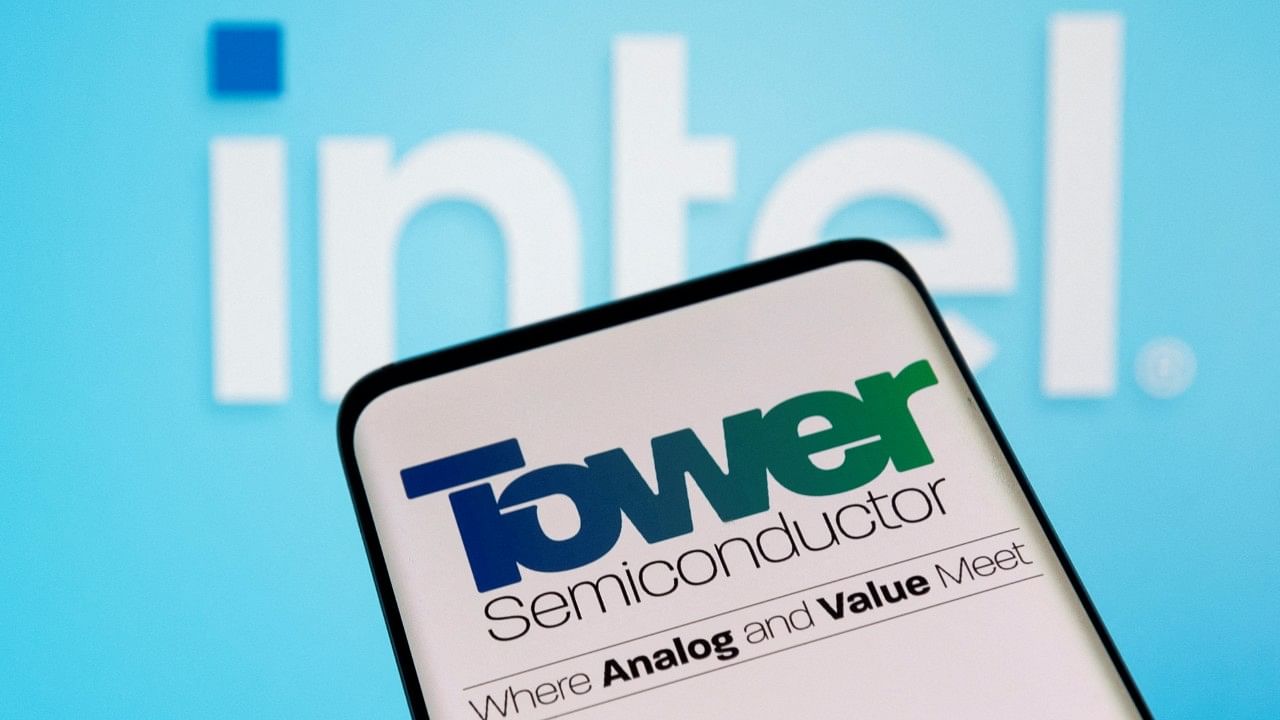
Tower Semiconductor is seen on smartphone in front of displayed Intel logo.
Credit: Reuters Photo
On August 15, as India was celebrating 76 years of Independence and with talks of India starting chip fabrication, a deal had fallen off in the world of semiconductors. Integrated device manufacturer (IDM) and semiconductor major Intel decided not to extend its $5.4 billion contract to acquire Israel-based pure play foundry (PPF) Tower Semiconductors.
Intel did not secure approval for the deal from Chinese regulators, and as August 15 was the deadline for the same, Intel decided to pay Tower Semiconductors a $353 million break-up fee and pursue no further.
Why is this development important for India?
Tower Semiconductors was the technology provider to the consortium International Semiconductor Consortium (ISMC), which had submitted in February 2022 an application under India’s Rs 76,000 crore semiconductor incentive scheme for a 65nm technology node analog fab. The application was stalled due to Intel’s acquisition plans of Tower Semiconductors.
In fact, none of the applicants from the ‘first round’, including Vedanta-Foxconn, were approved by the Ministry of Electronics and Information Technology (MeitY), prompting the scheme be reopened in June 2022 for a fresh round of applications.
Given these developments, what is next for Tower Semiconductors? Will it continue with its India plans?
To put it in the global context, as per the Q1-23 data published by TrendForce, a market intelligence consultant, Tower Semiconductors was the seventh in global foundry revenue with $356 million; its annual revenue is likely to be well over $1 billion. As per its technology offerings page, Tower Semiconductors has up to 45nm which are the state of the art for the kind of analog and other specialty semiconductor chips that it focuses on. The company is not new to collaborations, its 45nm fab in Japan is in collaboration with Panasonic, and is a partner along with STMicroelectronics for a fab in Italy with 130nm, 90nm, and 65nm
Tower Semiconductors has also been offering technology for private ventures to start a fab in India, at least since 2012; possibly even earlier. For reasons that could vary from challenges with the Indian investing partners to lack of solid government policy for incentives, nothing has come through yet.
Now that Tower Semiconductors is free from a possible acquisition deal, and quite likely not bound to ISMC, it could look for new Indian partners. There are reports of B C Jindal, RIL and HCL interested in what ISMC was trying to do, and perhaps now they could negotiate directly with Tower Semiconductors. Randhir Thakur who was the head of Intel Foundry Services (IFS) and who may have been involved in the 2022 Intel-Tower Semiconductors deal, now heads Tata Electronics. Thus, a Tata-Tower Semiconductors partnership could be on the cards. Likewise, after the Vedanta-Foxconn break up, it is not clear if Vedanta owns the production-grade technology license reportedly offered by STMicroelectronics to Vedanta Foxconn Semiconductor Ltd, and hence even a Vedanta-Tower Semiconductors partnership is possible.
As per Anshuman Tripathi who is in charge of semiconductors in the National Security Advisory Board (NSAB), for a technology transfer model of partnership with a fab that already produces commercial grade chips of that technology node in high volume, there has to be risk mitigation clauses in the contract like a capacity buying offer from the technology provider.
MeitY is likely to also insist that the technology provider take a stake of around 25 per cent. With increasing equipment and other costs, a fresh proposal for a 40,000 wafer starts per month (WSPM) 65nm analog fab may have a project cost of up to $4 billion, including a technology licensing fee of about $200-400 million for 65nm.
If a partnership between Tower Semiconductors and an Indian business is approved for an overall project cost of $4 billion, as per the modified incentive policy the Centre would give 50 per cent and a state like Gujarat or Uttar Pradesh or Odisha another 20-25 per cent. The investors must pool in the remaining, which is likely to be about $1.2 billion in this case. Tower Semiconductors could take a 25 per cent stake for $300 million, part or full of which can be earned back as license fee. Or, by offering 65nm production grade technology (at a cost of $300million) and $100 million as investment, Tower Semiconductors could grab one-third stake in a $4 billion fab.
Yet another possibility is of an Indian business house trying to buyout Tower Semiconductors and open a ‘branch’ fab in India, or at least take a non-trivial stake in Tower Semiconductors along with a commitment from Tower Semiconductors to invest some of that infused capital back into India and qualify for government incentives.
(Arun Mampazhy is a semiconductor engineer. Twitter: @nano_arun.)
Disclaimer: The views expressed above are the author's own. They do not necessarily reflect the views of DH.